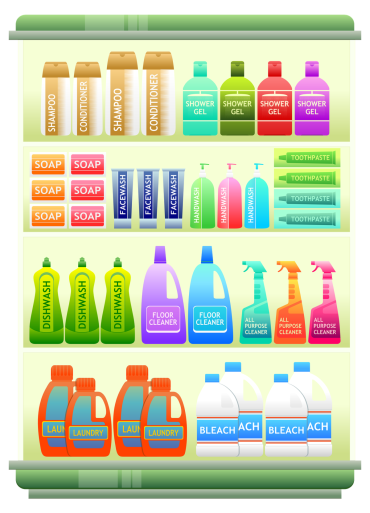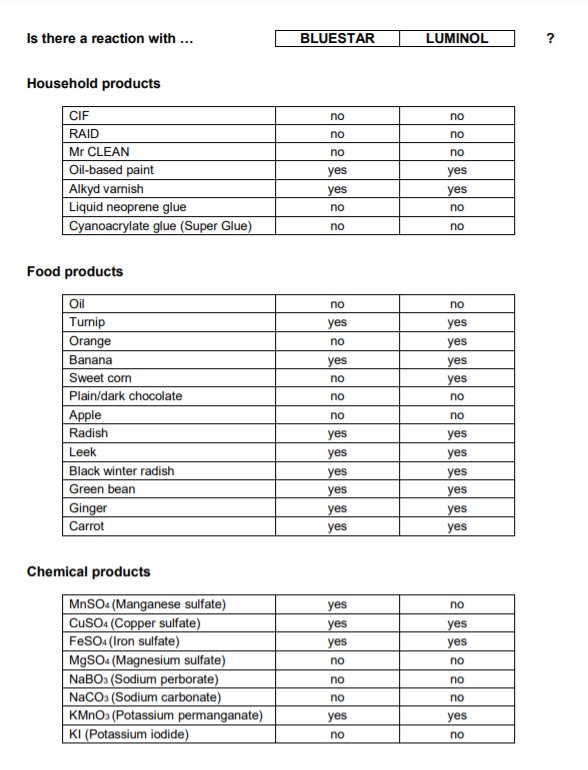1. BLUESTAR FALSE POSITIVES
The purpose of this study was to investigate the existence of false positives of the Bluestar product. This study
encompassed three kinds of products potentially present during the detection of blood traces: household products (home and cleaning products…), food products and chemicals. The analyses were not quantified and are therefore solely qualitative. Tests results are as follows:
1.1 Household products
- CIF: No reaction.
- RAID Fly/Mosquito Killer spray: No reaction.
- Mr. CLEAN New formula with grapefruit scent: No reaction.
The ordinary household cleaning products that were tested do not allow for the catalysis of chemiluminescence.
These products had been suspected since they were thought to possibly contain chlorine derivatives. They do not
seem to contain any. Furthermore, less and less products contain chlorine derivatives and are therefore rarely
capable of interfering with blood traces nowadays.

1.2 Food products
- Oil (sunflower, rapeseed, grape seed, olive): no reaction.
- Turnip
- Skin: white chemiluminescence that appears slowly (in fact the chemiluminescence is due to the flesh
that comes into contact with Bluestar later on) => no reaction due to the skin. - Flesh: highly persistent white to blue chemiluminescence (> 30 sec.); still some chemiluminescence
brightness after half an hour. - Juice: intense chemiluminescence (less than flesh)
- Skin: white chemiluminescence that appears slowly (in fact the chemiluminescence is due to the flesh
- Untreated orange: no reaction, either with peel or with pulp.
- Banana (washed in water)
- Peel: no reaction
- Pulp: intense white chemiluminescence (less than turnip), and persistent (about 30 sec).
- Non-GMO canned sweet corn (rinsed under water): no reaction.
- Plain dark chocolate (contains magnesium that could provoke chemiluminescence): no reaction.
BLUESTAR Copyright 2008 2 - Apple (rinsed under water): no reaction, either with peel or with pulp.
These first tests have pointed out a strong reactivity of foods containing fibers. Thus I took the initiative to test more
fiber products than initially planned.

- Radish
– Flesh: persistent white to blue chemiluminescence
– Skin: no reaction - Leek: chemiluminescent reaction inside fibers (inside the fibers but not in-between)
- Black winter radish
– Skin: no reaction
– Flesh: persistent blue reaction (particularly just under the peel). - Green bean: weak and non-lasting white chemiluminescence, on the fibers.
- Ginger
– Skin: no reaction
– Flesh: weak white chemiluminescence. - Carrot: weak but slightly long-lasting blue reaction.
- Sweet potato: no reaction.
Many fiber vegetables and fruits as well as radish-like vegetables are chemiluminescent in the presence of Bluestar.
1.3 Chemical products
All the solid chemicals were first dissolved into distilled water at a 0.1 mol/L concentration. Liquid chemicals
were diluted to obtain this same concentration.
- MnSO4 (Manganese sulfate): bright, short-lasting white chemiluminescence; build-up of a brown precipitate.
- CuSO4 (Copper sulfate): non-lasting blue chemiluminescence; build-up of a brown precipitate.
- FeSO4 (Iron sulfate): non-lasting blue chemiluminescence; build-up of a brown precipitate.
- MgSO4 (Magnesium sulfate): no reaction.
The Cu2+, Mn2+, and Fe2+ ions (the last one being similar to the ion present inside the hemoglobin molecule and
seemingly responsible for the blood luminescence) allow for the catalysis of the chemiluminescence reaction and
therefore are Bluestar false positives. Notice that the SO4
2-
sulfate ions do not catalyze the reaction since the last
test with MgSO4 did not yield any reaction. - NaBO3 (Sodium perborate): no reaction.
- NaCO3 (Sodium carbonate): no reaction.
None of the ions present in these two solutions is a Bluestar false positive. - KMnO3 (Potassium permanganate): short-lasting blue chemiluminescence.
- KI (Potassium iodide): no reaction.
The chemiluminescence of first solution is due to manganese, already proven as a false positive (see above).

1.4 Conclusion on Bluestar false positives
First, the tested products show that fiber foods are obviously Bluestar false positives. The reaction may vary from white to blue and can sometimes be very long-lasting (as with blood).
As far as household products are concerned, the tested paints and varnishes all react but the substance responsible for the reaction has not been clearly identified.
Finally, among the chemical products, the Bluestar false positives appear to be certain metallic ions such as Manganese, Copper and Iron (potentially present in the above Bluestar false positives).
2. LUMINOL FALSE POSITIVES
Read the complète study >
3. Test results synopsis : Bluestar and luminol tested false positives

Use of BLUESTAR®
at a suspected crime scene
How to take photographs
of the luminescence